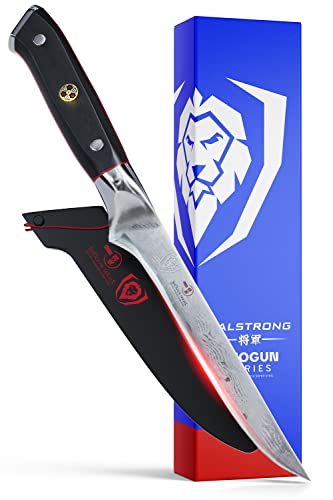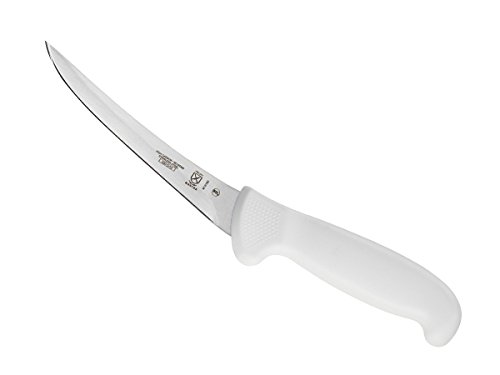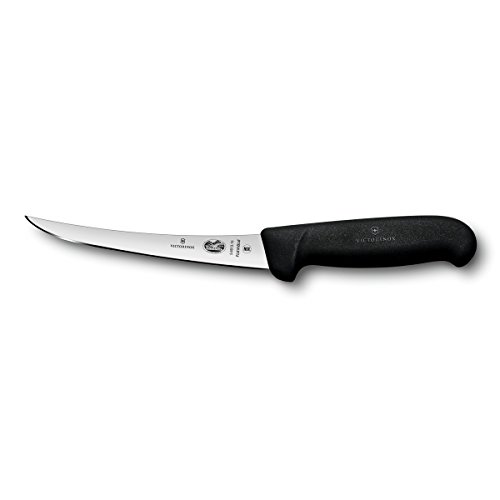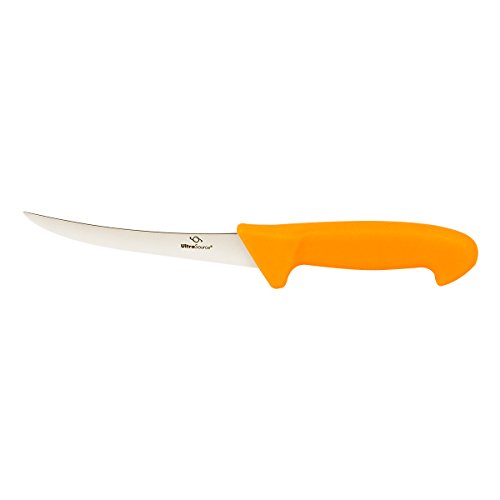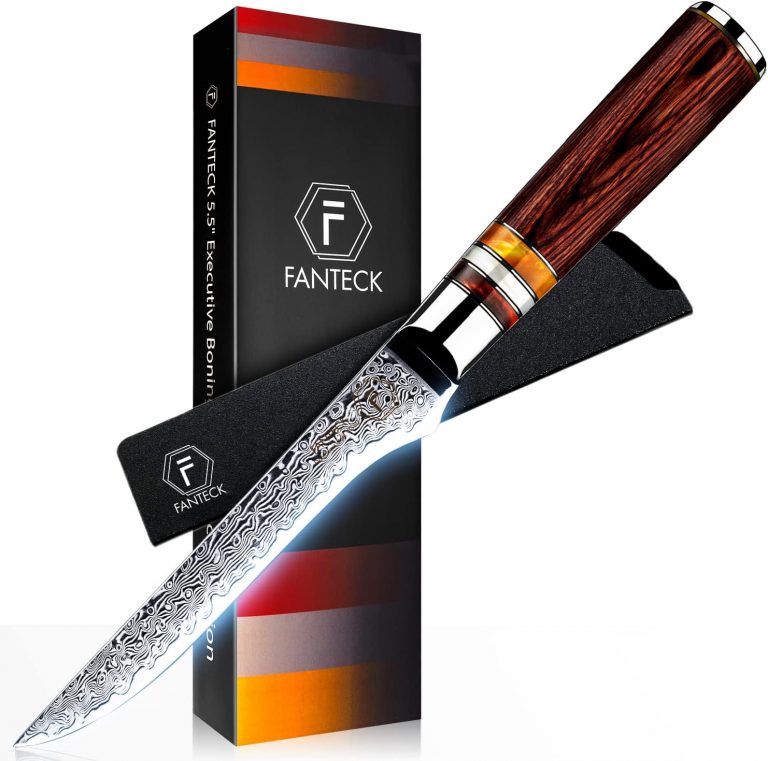- sign in
- Design
- Food
- Pop Culture
- Style
- DIY Classes
The Best Boning Knife to Easily Cut Through Meat
E-Commerce WriterPublished on September 15, 2023Last updated on May 1, 2024Ever wonder how restaurants get such perfect cuts of meat? Flexible boning knives trim close to the bone, ensuring an irresistible cut of meat every time. But this tool isn't just for professional chefs; it's a must-have for anyone serious about their cooking. While the market is brimming with a variety of boning knives, only the highest-rated ones make the cut in our kitchens. We're talking boning knives with powerful, razor-sharp steel and ergonomic handles for superb control. We've ranked our favorite boning knives of 2024 in this handy buying guide to ensure you get a choice selection of kitchen tools.
Experience precision like never before with the Dalstrong Shogun Series boning knife. Crafted from superb Damascus steel with a Japanese super steel core, this blade offers peak performance every ti...
read moreImportant Features- Sharp 8-12°degree angle per side edge
- Nitrogen cooled for enhanced resilience
- Core made of ultra-sharp AUS-10V Japanese super steel
- 67 layers of high-carbon Damascus steel
- Hand-polished ergonomic handle
The Mercer Culinary Curved Boning Knife quite literally brings an edge to your kitchen. Made from high-quality Japanese steel, this curved blade has some of the finest edge retention among knives av...
read moreImportant Features- Crafted with high-carbon Japanese steel
- Curved, 6-inch blade
- Durable polypropylene handle
- Non-slip grip with textured finger points
Step up your culinary game with the Victorinox Swiss Army Fibrox Pro Curved Boning Knife. This 6-inch marvel of Swiss engineering delivers precise and clean cuts, making it a must-have tool for any ...
read moreImportant Features- 6-inch stainless steel blade
- Curved blade for precise cuts
- Ergonomic, non-slip Fibrox Pro handle
- Lightweight and durable design
- Hygienic and dishwasher safe
Designed with the needs of butchers, meat processors, and food industry professionals in mind, the super sharp, UltraSource 449029 Boning Knife makes it a breeze to chop up large quarters of meat in...
read moreImportant Features- 6-inch curved blade
- Forged from high-carbon molybdenum steel
- Cryogenically treated for rust resistance
- Liquid-welded, textured handle
- Balanced blade and handle with safety bolsters
If you're cooking for guests and want to make an excellent impression, direct your attention towards the FANTECK Boning Knife. The Damascus steel used in this knife's blade creates a mesmerizing spi...
read moreImportant Features- 67 layer high-carbon Damascus steel
- Edge sharpened to 10-15 degrees
- Ergonomic Pakka wood handle
- Japanese high-carbon stainless steel core
- Includes storage box and knife sheath
A Chef's Guide to Boning Knives
The boning knife, with its narrow, sharp, and flexible blade, is a chef’s best friend when it comes to separating meat from bone. It easily cuts through ligaments and tendons, and often curves to reach difficult spaces near the bone. However, not all boning knives are equal. They vary in materials, length, flexibility, and more. Choosing the perfect boning knife is a delicate balance between your culinary needs, personal preferences, and budget. The right boning knife should enhance your precision and efficiency in the kitchen, whether you’re a novice cook or a seasoned chef. With this comprehensive guide, you’ll be well-equipped to make an informed choice. So, gear up for a culinary adventure!
Boning Knife Details To Keep Your Eyes Sharp For
Blade material
The blade material is what primarily determines the boning knife’s performance and lifespan. Stainless steel blades offer durability and a resistance to rust, but they may require frequent sharpening. High carbon stainless steel blades are tougher and hold their edge well, but may rust more easily without proper maintenance. Specialty metals, like Damascus steel, may be even sharper than more conventional blades, but often come at a higher price. Choose a blade material that best suits your cooking needs and maintenance preferences.
Blade length
Boning knives usually have blade lengths of 5 to 6.5 inches. Longer blades are perfect for larger cuts of meat, while shorter ones offer better control for more delicate tasks. Consider the type of food you usually prepare when choosing the blade length of your boning knife.
Flexibility
More flexible boning knives are great for maneuvering around bones and cartilage in poultry and fish. Stiffer knives provide more control, making them ideal for cutting thicker and tougher meats. Of course, flexibility and control are both key techniques to balance as you cut through meat. Your choice should reflect the type of meats you frequently handle, as well as your own ability to handle a knife. If you don’t have much experience using a boning knife, opt for a stiffer option to reduce accidents.
Handle material
Don’t underestimate the importance of a comfortable handle for your boning knife. Wood, plastic, and composite materials are common handle materials. Wood has a classic appeal and comfortable grip but can require more upkeep. Plastic handles are easy to clean and usually cheaper, but might not offer the best grip. Composite handles, made of both wood and plastic, strike a balance between comfort, grip, and durability.
Edge retention
Edge retention is the ability of the blade to maintain its sharpness over prolonged use. High-carbon stainless steel and ceramic blades usually excel in this regard. A boning knife with good edge retention saves you from frequent sharpening, but the rare occasion on which you do have to sharpen the blade may be harder.
Price
While you may not always need to go with the most expensive boning knife, don’t compromise on quality for price. A good boning knife is a long-term investment that can last for years if well-maintained.
Reviewing the Top Boning Knives of 2024
Experience precision like never before with the Dalstrong Shogun Series boning knife. Crafted from superb Damascus steel with a Japanese super steel core, this blade offers peak performance every time it leaves the sheath. Whether you’re filleting fish, carving meat, or deboning chicken, this boning knife makes every cut a breeze.
With a superior balance and control that’s second to none, this boning knife is a wonder to handle. Couple that with the ultra-sharp steel blade, and you have one of the finest knives available on the market. See how the steel on the sides of the knife forms distinct layers? This beautiful design comes from the traditional method for forging Damascus steel, used to make swords throughout medieval Arabia. Furthermore, this boning knife uses the traditional Japanese Honbazuke method to hone their blades to their absolute sharpest. The result is an ultra-sharp knife combining generations of steel crafting into one tool, which proudly sits at the top of our list.
Pros- Excellent balance and sharpness
- Beautiful design with Damascus steel layering
- Impressive edge retention ability
Cons- More expensive than competitors
Best Edge RetentionMercer Culinary Curved Boning Knife
The Mercer Culinary Curved Boning Knife quite literally brings an edge to your kitchen. Made from high-quality Japanese steel, this curved blade has some of the finest edge retention among knives available today. This means that you’ll rarely have to sharpen this blade. Thus, you get a low-maintenance boning knife ready to make prime cuts again and again.
Crafted from high carbon steel, this boning knife easily slices through meat, making it easy for you to make a perfect cut. The razor-sharp edge makes even the toughest meats easy to prepare. Plus, the polypropylene handle features an ergonomic design, making it all the easier to make especially precise cuts. Since the boning knife curves, you get even more leeway to carefully navigate around the bone, ensuring you the finest precision.
Pros- Durable Japanese steel provides excellent cutting
- Holds edge well
- Ergonomic handle for easy use
Cons- Difficult to re-sharpen
Step up your culinary game with the Victorinox Swiss Army Fibrox Pro Curved Boning Knife. This 6-inch marvel of Swiss engineering delivers precise and clean cuts, making it a must-have tool for any kitchen. Ideal for working close to and around the bone, this boning knife is particularly handy when handling fish or when precision cutting is paramount.
The ergonomic, non-slip, patented Fibrox Pro handle of this boning knife is a game changer. Comfortable and lightweight, it minimizes wrist tension; no matter the size of your hand or where you’re gripping the handle, you’ll feel in control. Even when wet or greasy, the textured handle ensures a secure grip. It’s like the boning knife isn’t a tool but an extension of your hand. Coupled with the thin, flexible blade, you’ll be able to make cuts with a surgical level of precision.
Pros- Comfortable and secure grip
- Precise and clean cuts
- Sturdy and durable design
Cons- Doesn’t come with sheath
Best for Meat ProcessingUltraSource 449029 Boning Knife
Designed with the needs of butchers, meat processors, and food industry professionals in mind, the super sharp, UltraSource 449029 Boning Knife makes it a breeze to chop up large quarters of meat into individual cuts and roasts.
This boning knife packs a number of features specially designed to help butchers with their work. Protective finger guards lie at both ends of the handle to keep fingers safe during long periods of work. The cryogenically-treated blade resists rust, and the antimicrobial handle keeps the boning knife hygienic and safe. And, of course, the razor-sharp edge, made from German steel, seamlessly glides through the meat for precise cuts. This particular boning knife features a semi-flexible level of rigidity, letting it comfortably work near the bones of pork, beef, poultry, and fish.
Pros- Very sharp and sturdy knife
- Rust-resistant edge
- Easy to clean the handle and blade
Cons- Handle thickness leads to uncomfortable grip
Most Elegant DesignFANTECK Boning Knife
If you’re cooking for guests and want to make an excellent impression, direct your attention towards the FANTECK Boning Knife. The Damascus steel used in this knife’s blade creates a mesmerizing spiral pattern, sure to turn heads as you prepare a masterful dinner. The blade isn’t just for show, though. The hand-sharpened blade offers some of the finest performance you can get from a boning knife.
Sharpened to an angle of 10 degrees on either side, the razor on this boning knife is sharp enough for even the toughest meats. And with 67 layers of steel, the knife is sure to stay sharp for years. The Pakka wood handle gives excellent grip with just the right amount of balance for chopping, dicing, and boning meat. This elegant boning knife comes complete with a wooden storage box and a custom knife cover.
Pros- Powerful Damascus steel for superb cuts
- Easy handling with wooden grip
- Luxurious design
Cons- Straight blade could be more maneuverable
Boning Knife FAQs
Q: What is a boning knife used for?A: Butchers and chefs primarily use boning knives to separate meat from the bone, make precise cuts, or to skin fish or poultry. Its thin, flexible blade allows for easy maneuverability around bones and joints.
Q: How do I properly use a boning knife?A: To use a boning knife, firmly grip the handle while keeping your fingers away from the blade. Carefully slide the blade along the bone, using a sawing motion and maintaining control of the blade at all times.
Q: What are some safety tips when using a boning knife?A: Ensure the knife is always sharp to reduce the risk of slipping and causing injury. Always cut away from your body and keep your fingers clear of the blade. After use, clean and store the knife properly.
Q: How should I clean and maintain my boning knife?A: You should clean your knife after each use with warm soapy water, then dry it thoroughly to prevent rusting. Some boning knives are dishwasher safe, but hand washing will prolong the knife’s life. Regularly sharpen the knife with a knife sharpener to maintain its edge.
Q: What should I do if my boning knife becomes dull?A: If your boning knife becomes dull, you can sharpen it using a knife sharpener or honing rod. If you're not comfortable doing this yourself, take it to a professional knife sharpener.
Q: What materials are boning knives typically made of?A: Boning knife blades are often high-carbon stainless steel, which provides a good balance of sharpness, edge retention, and resistance to rust.
We may earn a commission if you make a purchase through one of our links. The newsroom or editorial staff was not involved in the creation of this content.Natalie is a graduate from the Ohio State University where she studied English. She edits content about lifestyle and education. In her free time, she enjoys trying new recipes, reading in the park, and exploring her city of Columbus, Ohio.

